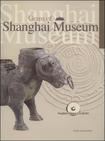上海博物馆珍品
出版时间:2007-1 出版社:人民教育出版社 作者:陈燮君 主编 页数:291
Tag标签:无
前言
Founded in 1952, the Shanghai Museum holds for China and the world agrand collection of history, art and antiquities from ancient and livingcultures. The Shanghai Museum was allocated to the current site People'sAvenue 201 by the Shanghai Municipal Government in 1993 and reopenedto the public in 1996. Erected at the center of the People's Square,the Shanghai Museum, together with the Shanghai Grand Theatre, theCity Hall, and the Shanghai City Planning Museum, makes an impressiveskyline of the metropolis and contributes to its cultural and economiclife.Designed in a round-cover-and-square-body style, its building embodiesthe traditional Chinese concept of "the heaven is round and the earth issquare". With an area of 39,200 square meters and a height of 29.5 meters,the Shanghai Museum has 10 permanent galleries and 3 temporary exhibitionhalls. Since its foundation, the Shanghai Museum has been committingto conserving, protecting, restoring, authenticating and developingChina's national culture and art treasures. Its collection continues togrow and now houses over one million works, among which 120,000 areof high value. Through five thousand years of ancient China's brilliantcivilization, its magnificent works cover about 21 types, including bronzes,ceramics, calligraphy, painting, jade, ivories, bamboo and wood wares,lacquered wares, oracle bones, seals, coins, furniture, etc. Its bronzes,ceramics, painting and calligraphy collections are among the most comprehensiveand finest in the world. One of the latest and the most notableadditions to its collection is the Chunhua Ge Tie (a calligraphy robbingcollection) purchased in 2003.
内容概要
The Shanghai Museum became a must-go landmark for its international standing and its key role in the display of our nation’s cultural heritage.In recent years,over 1 million people visit the Shanghai Museum every year and about half of them are foreigners.We are obliged to make the appreciation of the valuable collections possible to the great number of people from china and all over the world.In order to promote universal understanding of our collections and the culture behind them,we have been longing to introduce the Shanghai Museum in languages besides Chinese.
书籍目录
Ancient Chinese Bronze GalleryA History of Ancient Chinese BronzeInitial Stage(3),Developing Stage (3),Zenith Stage(3),Transition Sage(4),Renewal Stage(4)Classifications of BronzesFood VesselsCooking Vessels:Ding (6), Li (6), Yan (6)Food Containers:Gui (6), Xu (7). Dui (7), Dou (7)Wine VesselsDrinking Vessels:Jue (7). Jia (8). Gu (8), Zhi (8)Wine Containers:Hu (8), You (9). Zun (9), Lei (9),Ling (9), Pou (9), Gong (10),Square Yi (10)Wuter Vessels: Pan (10), He (10), Yi (11), Jian (11)Musical hzstruments: Nao (11), Zhong (11), Drum (12)Weapons and Others: Yue (12), Jian (12), Sheng (12),Btvnze Pillow (13),Cowrie Container (13),Btvnze Mirror (13)Decorations on the BronzeAnimal Musk Design (14),Dragon Desitcn (14),PhoenLr Design (14), Animal Design (15),Metamorphosed Animal Design (15),Geometric Design (15), Puinting Design (16)Casting TechniquesPiece-mold Method (17), Lost-wax Methnd(18)Dcrcrativc Craft, manshipAncient Chinese Sculpture GalleryA History of Ancient Chinese SculptureBuddha Figure SculpturesAncient Chinese Ceramics GalleryA History of Chinese CeramicsFamous Kilns in Ancient TimesMajor Types of CeramicsAncient Chinese Painting GalleryA History of Ancient Chinese PaintingMajor Types of Traditional Chinese PaintingAncient Chinese Calligraphy GalleryA History of Chinese CalligraphyMajor Types of Chinese CalligraphyAncient Chinese Seal GalleryA History of Ancient Chinese SealsChinese Ming and Qing Furniture GalleryChinese Ming and Qing FurnitureAncient Chinese Jades GalleryA History of Ancient Chinese JadesChinese Minority Nationalities' Art GalleryCraft of Chinese Minority NationalitiesAncient Chinese Coins GalleryA History of Ancient Chinese CoinsAppendix Ⅰ:Articles IncludedAppendix Ⅱ:Table of Chinese Dynasties
章节摘录
插图:Initial StageBronze, an alloy of copper, till and lead, can be used to fashion ritualvessels, tools and weapons. The arrival of bronze heralded a new age inthe history of China. The era of the Shang and the Zhou dynasties isgenerally known as the Bronze Age of China.Eriitou Culture marks the beginning of Chinese bronze casting, whichdated from 5,000 years ago. The range of types of vessel cast was quitebroad, including containers, musical instruments, weapons, tools andpersonal ornaments. Ruins of foundries were also found at the site.In China, as in other societies, rituals carried a very important socialfunction in generating social cohesion and in ruling the state. Ritualbronzes of this period were thin-walled and cast by mature techniques.Developing StageDuring the early and middle Shang Dynasty (16th-13th century B.C.),bronze casting became a major state industry. Ritual vessels producedthen were mainly wine containers. A feature common to this period'sbronzes was their relatively thin walls. Decoration trended towards morebold and complex, and the most popular motif was the animal-mask. Themold-making process became sophisticated and an ingenious techniquewas developed for casting a complicated shape in a sequence of separatepouring of metal. The progress laid a solid foundation for the comingzenith of the bronze art.
编辑推荐
《上海博物馆珍品》由人民教育出版社出版。
图书封面
图书标签Tags
无
评论、评分、阅读与下载
用户评论 (总计1条)
- 光盘内容对我来说浅了点,这本英文书准备给宝宝学英语用。
推荐图书
- 天津
- 申论真题冲刺/山东省录用公务员考试专用教材
- 行政职业能力测验应试指导及深度训练/山东省录用公务员考试专用教材
- 行政职业能力测验应试指导及深度训练
- 自主创新实现物流工程的持续与科学发展
- 铁路企业思想工作的实践与思考
- 财经应用数学学与练
- 基础工程
- 理论力学
- 理论力学
- 弹性力学
- 应用波谱学
- 先进的城市交通规划理论方法和模型
- 铁路临客客运乘务员
- 燃气锅炉
- 25K新型客车仿真培训软件
- 铁路货车段修规程仿真培训软件
- 铁路工务概述仿真培训软件
- 铁路道岔仿真培训软件
- (8)铁路工务修理规则仿真培训软件
- 铁路工务常用检测工具仿真培训软件
- 铁路货物装载加固术语培训软件
- (8)铁路工务安全规则仿真培训软件
- 铁路路基仿真培训软件
- 铁路行车信号多媒体培训软件
